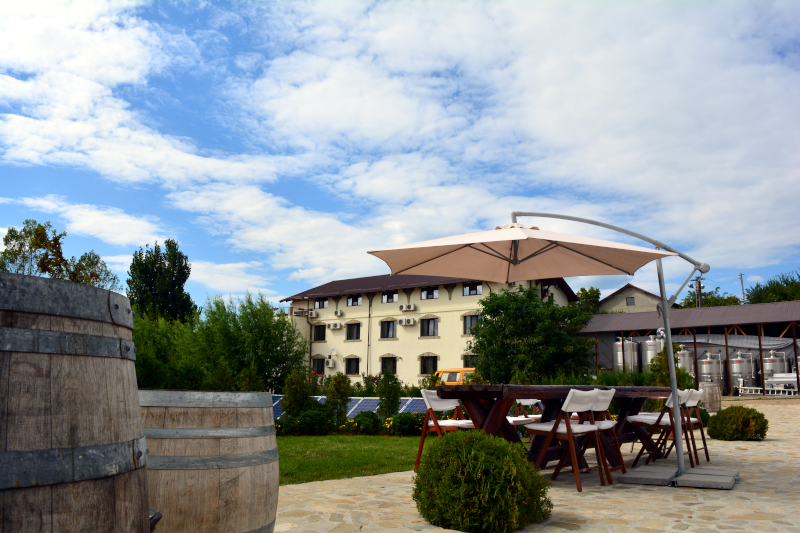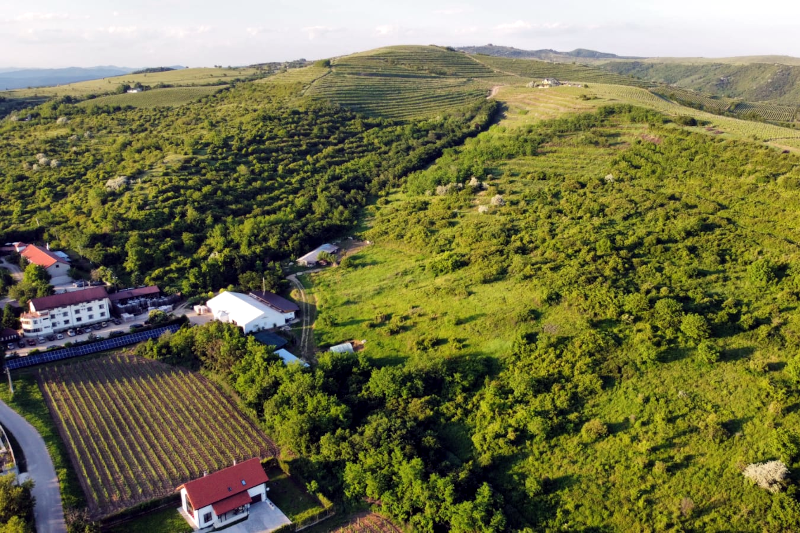
A dialogue with Stefan Ionescu, the founder of the “1000 de Chipuri” winery, about wine tourism in Dealu Mare: who are the customers, why has demand increased, how much does a tasting package cost, and what are the accommodations. How (and if) central and local authorities are involved in supporting this important activity for the wine industry in Romania.
What is the difference between wine tourism, wine tourism and a winery visit?
These three terms actually mean the same thing, they differ only in the context in which they are used. “Wine tourism” is a more sophisticated name that gives a European and even a little Latin openness. A “winery visit” usually has a correspondent at the level of families or groups of friends who want to see the winemaking process and do a tasting on site. “Vine tourism” is a general term that tries to bring the producers closer to the state authorities so that they understand that this type of tourism, which has recently appeared, has its own meaning for the wine industry.
Who are the clients of wine tourism?
If we give a general definition (jokingly, more seriously), then customers of wine tourism are all those people who are over 18 years old and who do not have medical contraindications to drinking alcohol. In theory, we want to have a mature audience with education and financial resources, but in practice the reach is much wider, according to the above definition.
After 10 years of wine tourism experience at the winery “1000 de Chipuri”, I can say that at first the customers were mainly wine enthusiasts, but recently more and more people who do not have a direct connection with the industry, but who want to learn and live an interesting experience. At first, there were very few corporate clients, but now there are more and more companies that come to organize team building or a meeting at the winery. Many foreigners came before the pandemic, only Romanians came during the pandemic, and Romanians and foreigners came equally after the pandemic. The 1000 Faces winery is dominated by corporate customers (team building, meetings) during the week, and private individuals mostly come on weekends.
What caused the growth in demand for wine tourism?
Wine tourism today is no longer a niche, as it was a few years ago. The main reason, in my opinion, is the increase in the purchasing power of potential customers. Secondly, the level of understanding and education of people about wine has increased. Third, many wineries have made ongoing efforts to promote this type of tourism as an integral part of their marketing strategy. Wineries communicated better and a “critical mass” was reached, which also attracted travel agencies to this niche. We must not forget the time of the pandemic, when many chose wine tourism as an alternative to escape from isolation. Unfortunately, many customers who contacted us during the pandemic are now moving to wine regions abroad. A friend from Banat recently told me: “It’s 7 hours from Timisoara to Dealu Mare, but much less to Tuscany!”

Photo: Winery “1000 Faces” by Dealu Mare
How much does the 1000 de Chipuri wine tour cost and what does it include?
Our package includes wine tasting and accommodation in the guesthouse of the winery, and meals are paid separately (we also have an à la carte restaurant). For two people, wine tasting and accommodation cost from 500 to 800 lei (depending on how many wines are included in the tasting: 6, 8 or 10 labels). Tasting lasts about 2-3 hours. There is no minimum number of people for a tasting at 1000 Faces: we organize 2-3 tastings per day, at a fixed time, and anyone who comes to the winery can participate in any of them. For those who stayed overnight, the tasting begins at 7 p.m. I have done tastings with 2 but also with 150 people!
Is wine tourism possible without accommodation?
Of course it can be done, but over time I can’t say I haven’t seen many people with sad faces as drivers arriving at the winery and watching others tasting the wines. If there is no accommodation at the winery, an alternative solution can be offered by a travel agency that can take customers by bus even to several wineries in one day. We recommend that those visiting 1000 Faces stay overnight at the winery’s guest house (Casa Colinelor) to get the full experience. Our boarding house can accommodate about 40 people.
Can wine tourism be a profit center for a winery?
I believe that wine tourism should be seen primarily as a means of promoting wineries and wines, not as a profit center. From my point of view, the wine business in Romania should be focused on production, and I see wine tourism only as an effective promotion tool. When you have more than 60 hectares of vineyards to take care of (the case of the winery “1000 de Chipuri”) and you want to get only very high quality wines, wine tourism is important, above all, as a means of communication and loyalty. wine lovers
What percentage of a winery’s sales can be derived from wine tourism?
Going back to what I said above, any producer who engages in wine tourism should do so with a specific goal in mind, which is to promote wine. Obviously, over time, if this activity is well organized, it can turn from a cost center to a profit center, but I don’t think it can exceed 20-25% of the main wine business.

Photo: “1000 Faces” winery, bird’s eye view
Why has Dealu Mare become an attractive destination for wine tourism?
First of all, because here, not far from the capital, there is a large concentration of wineries. Secondly, the overcrowding of Vala Prahova is another (admittedly secondary) reason why some tourists choose the Dealu Mare area in favor of the Bucheji mountain areas, even if in this case we are talking about completely different impressions (the winery does not look like a mountain and vice versa).
As for corporate clients, they are overwhelmingly from Bucharest, because there are many headquarters of multinational companies. On the other hand, the private individuals who visit us come from all regions of the country, and their motivation lies more in passion than in any professional obligations, as in the case of corporate clients.
Why is wine tourism important for winemaking?
When we started wine tourism at the “1000 Faces” Winery, there were 2 accommodation facilities in the whole Dealu Mare region, at the moment there are about 5 and most likely in the coming years there will be more than 10. Obviously, the accommodation capacity in this area is growing in proportion to the wine tourism market.
Wine tourism is important, first of all, to increase the popularity of Romanian wine within the country and abroad. Here we are talking about a way to increase the entire category of Romanian wine products, not just to promote one or another winery. Second, it is a good way to keep Romanian tourists in the country, as well as attract tourists from abroad who are already used to this experience.
Since the Romanian wine authorities are always one step behind other countries, I would like to at least not be far behind. The Romanian state must understand that wine tourism does not only help Romanian wine. This type of tourism equally promotes Romanian gastronomy, Romanian landscapes and ultimately the brand of our country.
We must acknowledge the fact that the Ministry of Agriculture and Rural Development (MADR) has made efforts through APIA (Agriculture Payments and Intervention Agency). Currently, there are European funds for investments that concern, among other things, wine presentation and tasting facilities. This is very important and helps. However, there is no doubt that more could be done: in neighboring countries (and I mean, in particular, Bulgaria) they also give money for the construction of living quarters at wineries.
If MADR understands the importance of wine tourism, I cannot say the same for the Ministry of Economy, Enterprise and Tourism (MEAT), which still considers Dealu Mare a non-tourist area. Practically, Dealu Mare does not use points for construction in the tourism sector.
Even the local authorities of Dealu-Mare (a region that includes 2 counties: Prahova and Buzeu) did not understand that they needed to work together. Basically there is a wine road in Prahov and another one in Buzău, which unfortunately do not meet as it would be normal.
The article is supported by the “1000 Faces” Winery.
Source: Hot News
Ashley Bailey is a talented author and journalist known for her writing on trending topics. Currently working at 247 news reel, she brings readers fresh perspectives on current issues. With her well-researched and thought-provoking articles, she captures the zeitgeist and stays ahead of the latest trends. Ashley’s writing is a must-read for anyone interested in staying up-to-date with the latest developments.